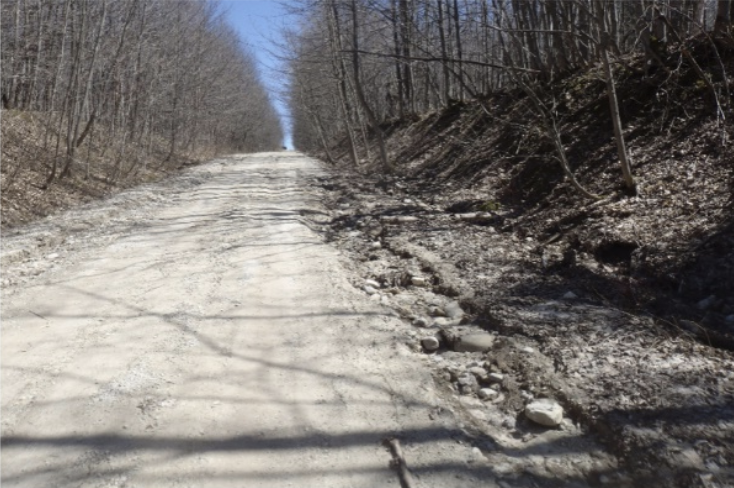Our legal efforts at the Ontario Land Tribunal represent an almost 10-year odyssey of research, opposition and advocacy, that resulted in a massive win for the Trust and for the environmentally significant Sideroad 26-27, protecting the two most sensitive land use designations within the Niagara Escarpment and preserving cold water fisheries and steep escarpment slopes.
The story begins in January 2014 with a preliminary development permit application made by Walker Industries to the Niagara Escarpment Commission (NEC) to redevelop seasonal Side Road 26/27 in order to export rock from its new quarry. Side Road 26/27 was considered by Walker and Clearview Township to be a suitable replacement for Simcoe County Road 91, which was sold to Clearview by Simcoe County. Clearview proposed to close County Road 91 to allow for the Walker expansion and reroute traffic to Side Road 26/27.
In November 2015 the NEC decision came down, outlining that in order to redevelop seasonal Side Road 26/27, Clearview would require a NEC Development Permit. Subsequently Clearview’s Development Application was refused by the NEC by a vote of 12 to 1, on the basis that Side Road 26/27 did not meet the definition of “essential”. Walker had already constructed a tunnel under County Road 91 allowing them to export aggregate from the new quarry without the necessity to close 91. Clearview immediately appealed the NEC Decision to the Ontario Land Tribunal.
By March 2016, Clearview’s Environmental Impact Study reported 3 additional wetlands on 27/27 Sideroad. The Blue Mountain Watershed Trust completed its own environmental investigations between 2015 and 2018 and our consultant identified seven additional wetlands not included in Clearview’s study.
These new findings required Clearview to make an application to amend the Niagara Escarpment Plan to permit infrastructure improvements to seasonal Side Road 26/27. It was during this time that the Blue Mountain Watershed Trust Foundation committed to opposing Clearview’s application in the courts.
Clearview’s Niagara Escarpment Plan Amendment Application was submitted in 2018, and in 2020, NEC staff recommended the application be referred to the Ontario Land Tribunal.
Between 2021 and 2022, parties including the Watershed Trust prepared for a hearing at the Ontario Land Tribunal on both the Development Permit Application appeal and the Niagara Escarpment Plan Amendment Application. The hearing was delayed several times and ultimately adjourned while the parties awaited a decision from the Ontario Ministry of Environment, Conservation and Parks (MECP) on the appropriate level of environmental assessment required for the redevelopment.
Concurrently, members of the Trust and the Watershed Action Group (WAG) undertook widespread advocacy efforts to build financial, legal, and moral support for what could be a complex and expensive hearing. In a single live online event in 2022 (necessitated by Covid), we were successful in raising almost $40,000.
At the end of 2022 the MECP finally determined that Clearview must complete a Schedule C Municipal Class Environmental Assessment, and not the Schedule A+ Assessment proposed by Clearview. Among other things, a Schedule C Assessment would require public input and the consideration of alternative solutions and would cost substantially more to complete. The Watershed Trust had been calling for a Schedule C Assessment since December 2016, including a “bump-up” request which had originally been denied by the MECP in March 2019. The reversal of the MECP’s decision was a significant achievement for BMWT.
Subsequently, in March 2023 Clearview requested to withdraw its Development Permit appeal from the Ontario Land Tribunal and its Niagara Escarpment Plan Amendment Application. In December 2023, the BMWT WAG committee recommended closure of the Side Road 26/27 file.
This was the best possible outcome to a long and arduous fight. While our WAG group was integral to recognizing and building the case for opposition of the 26/27 Sideroad expansion, the collective effort of residents in Clearview, Grey Highlands, and the Town of the Blue Mountains also played a pivotal role in achieving success.
In the landscape of the Ontario Land Tribunal, it is uncommon for development applications to be declined. BMWT attributes this achievement to the strong leadership of our legal counsel, the persistent efforts of BMWT itself, and the generous financial support provided by our members and concerned citizens in the area.
We are especially grateful to Davies Ward Phillips & Vineberg LLP and their lawyers, Sarah Powell and Robyn Barabash, without whose invaluable pro bono assistance we could not have continued our opposition efforts over years and multiple tribunal hearings.
We also extend our heartfelt gratitude to individuals such as Wendy Franks, David Stevenson, Doug Dingeldein, and Margaret Hutchison, whose support and dedication were instrumental in this success.
BMWT remains steadfast in our commitment to protecting and enhancing the Blue Mountain Watershed. This successful resolution reinforces our dedication to safeguarding the natural environment for the benefit of current and future generations.



